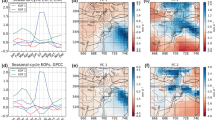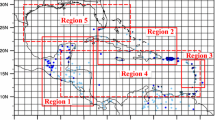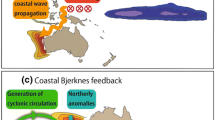Abstract
This study explores how the Caribbean mean diurnal cycle is represented in observed, reanalyzed, and general circulation model data of the CMIP3 generation, with a focus on the central Antilles Islands (18–21° N, 80–66° W). Their trade wind climate, high solar forcing, and eastward decrease in size challenge dataset ability to represent a diurnal cycle of sufficient amplitude and correct phase. The mean difference between maximum and minimum temperature (ΔT) provides a useful metric, and values of 5–12°C are observed at stations around the Caribbean basin. The ΔT in various reanalyses and CMIP3 models generally yield correct values over South America, but few exhibit elevated ΔT over the central Antilles Islands. NCEP2 and ECMWF reanalyses differ in their representation despite similar resolution, the latter reflecting elevated ΔT. Only one of the four CMIP3 models evaluated correctly simulates Antilles ΔT, but does so with a dry bias. An intercomparison of mean diurnal rainfall in the Antilles is conducted. According to satellite and high-resolution reanalysis, the rain rate doubles in the afternoon. However NCEP2/ECMWF reanalysis and CMIP3 models yield an amplitude about half the observed and exhibit a nocturnal peak typical of marine climates. The reason for the variety of outcomes is related to model parameterizations that translate surface fluxes to boundary layer responses, and to horizontal resolution that affects the representation of sea breeze confluence over large islands.







Similar content being viewed by others
References
Albright MD, Mock DR, Recker EE, Reed RJ (1981) A diagnostic study of the diurnal rainfall variation in the GATE B-scale area. J Atmos Sci 38:1429–1445
Albright MD, Recker EE, Reed RJ, Dang R (1985) The diurnal variation of deep convection and inferred precipitation in the central tropical Pacific during January–February 1979. Mon Weather Rev 113:1663–1680
Augustine JA (1984) The diurnal variation of large-scale inferred rainfall over the tropical Pacific Ocean during August 1979. Mon Weather Rev 112:1745–1751
Brest CL, Rossow WB, Roiter M (1997) Update of radiance calibrations for ISCCP. J Atmos Oceanic Technol 14:1091–1109
Chang ATC, Chiu LS, Yang G (1995) Diurnal cycle of oceanic precipitation from SSM/I data. Mon Weather Rev 123:3371–3380
Chen SS, Houze RA (1997) Diurnal variation and life-cycle of deep convective systems over the tropical Pacific warm pool. Q J Roy Meteorol Soc 123:357–388
Delworth TL et al (2006) GFDL’s CM2 global coupled climate models. Part 1: formulation and simulation characteristics. J Climate 19:643–674
Ffield A (2007) Amazon and Orinoco River plumes and NBC rings: bystanders or participants in hurricane events? J Climate 20:316–333
Garreaud RD, Wallace JM (1997) The diurnal march of convective cloudiness over the Americas. Mon Weather Rev 125:3157–3171
Gilleland E, David A, Brown BG, Casati B, Ebert EE (2009) Intercomparison of spatial forecast verification methods. Weather Forecast 24:1416–1430
Gnanadesikan A et al (2006) GFDL’s CM2 global coupled climate models. Part 2: baseline ocean simulation. J Climate 19:675–697
Gray WM, Jacobson RW (1977) Diurnal variation of deep cumulus convection. Mon Weather Rev 105:1171–1188
Griffies S et al (2006) Formulation of an ocean model for global climate simulation. Ocean Sci 1:45–79
Hasumi H, Emori S (2004) K-1 (MIROC) model development, K-1 Tech. Rep. 1, Frontier Research Center for Global Change, Japan, pp 39
Hendon HH, Woodberry K (1993) The diurnal cycle of tropical convection. J Geophys Res 98:16523–16637
Hourdin FI, Musat S, Bony P, Braconnot F, Codron J-L, Dufresne L, Fairhead M-A, leFiliberti P, Friedlingstein J-Y, Grandpeix G, Krinner P, leVan Z-X, Li F, Lott (2006) The LMDZ4 general circulation model: climate performance and sensitivity to parametrized physics with emphasis on tropical convection. Clim Dyn. doi:10.1007/s00382-006-0158-0123
Janowiak J, Arkin PA, Morrissey M (1994) An examination of the diurnal cycle in oceanic tropical rainfall using satellite and in situ data. Mon Weather Rev 122:2296–2311
Joyce RJ, Janowiak JE, Arkin PA, Xie PP (2004) CMORPH: a method that produces global precipitation estimates from passive microwave and infrared data at high spatial and temporal resolution. J Hydrometeorol 5:487–503
Jury MR (2009) An inter-comparison of observational, reanalysis, satellite, and coupled model data on mean rainfall in the Caribbean. J Hydrometeorol 10:413–430
Jury MR, Chiao S, Harmsen EW (2009) Mesoscale structure of trade wind convection over Puerto Rico, composite observations and numerical model simulation. Boundary-Layer Meteorol 132:289–313
Kanamitsu M, Ebisuzaki W, Woollen J, Yang SK, Hnilo JJ, Fiorino M, Potter GL (2002) NCEP-DOE AMIP-II reanalysis (R-2). Bull Am Meteorol Soc 83:1631–1643
Krinner G, Viovy N, de Noblet-Ducoudré N, Ogée J, Polcher J, Friedlingstein P, Ciais P, Sitch S, Prentice IC (2005) A dynamic global vegetation model for studies of the coupled atmosphere-biosphere system. Glob Biogeochem Cycles 19:GB1015. doi:10.1029/2003GB002199
Liu C, Moncrieff MW (1998) A numerical study of the diurnal cycle of tropical oceanic convection. J Atmos Sci 55:2329–2344
Mapes BE, Warner TT, Xu M, Negri AJ (2003) Diurnal patterns of rainfall in northwestern South America. Part I: observations and context. Mon Weather Rev 131:799–812
Marti O et al. (2006) The IPSL4 climate system model: IPSL-CM4, Inst. Pierre Simon Laplace, Paris, Technical report, pp 84
McGarry MM, Reed RJ (1978) Diurnal variations in convective activity and precipitation during phases II and III of GATE. Mon Weather Rev 106:101–113
Meehl GA, Covey C, McAvaney B, Latif M, Stouffer RJ (2005) Overview of the coupled model intercomparison project (CMIP). Bull Am Meteorol Soc 86:89–93
Meehl GA, Covey C, Delworth T, Latif M, McAvaney B, Mitchell JFB, Stouffer RJ, Taylor KE (2007) The WCRP CMIP3 multimodel dataset: a new era in climate change research. Bull Am Meteorol Soc 88:1383–1394
Mesinger F et al (2006) North American Regional Reanalysis. Bull Am Meteorol Soc 87:343–360
Mitchell TD, Jones PD (2005) An improved method of constructing a database of monthly climate observations and associated high-resolution grids. Int J Climatol 25:693–712. doi:10.1002/joc.1181
Phillips TJ (1994) A summary documentation of the AMIP models. PCMDI Rep. 18, Lawrence Livermore National Laboratory, pp 343
Poveda G et al (2005) The diurnal cycle of precipitation in the tropical Andes of Colombia. Mon Weather Rev 133:228–240
Randall DA, Harshvardhan, Dazlich DA (1991) Diurnal variability of the hydrologic cycle in a general circulation model. J Atmos Sci 48:40–62
Reichler T, Kim J (2008) How well do coupled models simulate today’s climate? Bull Am Meteorol Soc 89:303–311
Ringer M (1998) Tropical convective rainfall in the global UM: Initial comparisons with estimates derived from Meteosat infrared imagery. Forecasting Research Tech. Rep. 239, The Met. Office, Bracknell, United Kingdom, pp 33
Roeckner E et al (2006) Sensitivity of simulated climate to horizontal and vertical resolution in the ECHAM5 atmosphere model. J Climate 19:3771–3791
Rossow WB, Walker A, Roiter M (1997) International Satellite Cloud Climatology Project (ISCCP): description of reduced resolution radiance data. WMO/TD-58, Geneva
Saha S et al (2010) The NCEP climate forecast system reanalysis. Bull Am Meteorol Soc 91:1015–1057
Salby ML, Hendon HH, Woodberry K, Tanaka K (1991) Analysis of global cloud imagery from multiple satellites. Bull Am Meteorol Soc 72:467–480
Shin K-S, North GR, Ahn Y-S, Arkin PA (1990) Time scales and variability of area-averaged tropical oceanic rainfall. Mon Weather Rev 118:1507–1516
Sitch SB, Smith IC, Prentice A, Arneth BA, Cramer W, Kaplan J, Levis S, Lucht W, Sykes M, Thonicke K, Venevsky S (2003) Evaluation of ecosystem dynamics, plant geography and terrestrial carbon cycling in the LPJ dynamic global vegetation model. Glob Chang Biol 9:161–185
Sui C-H, Lau K-M, Takayabu YN, Short DA (1997) Diurnal variations in tropical oceanic cumulus convection during TOGA COARE. J Atmos Sci 54:639–655
Uppala SM et al (2005) The ERA-40 re-analysis. Q J Roy Meteorol Soc 131:2961–3012
Wang C, Enfield DB, Lee S-K, Landsea CW (2006) Influences of the Atlantic warm pool on western hemisphere summer rainfall and Atlantic hurricanes. J Climate 19:3011–3028
Webster PJ, Clayson CA, Curry JA (1996) Clouds, radiation and the diurnal cycle of sea surface temperature in the tropical western Pacific Ocean. J Climate 9:1712–1730
Weller RA, Anderson SP (1996) Surface meteorology and air–sea fluxes in the western equatorial Pacific warm pool during the TOGA Coupled Ocean–Atmosphere Response Experiment. J Climate 9:1959–1990
Yang GY, Slingo JM (2001) The diurnal cycle in the tropics. Mon Weather Rev 129:784–801
Author information
Authors and Affiliations
Corresponding author
Rights and permissions
About this article
Cite this article
Jury, M.R. Representation of the Caribbean mean diurnal cycle in observation, reanalysis, and CMIP3 model datasets. Theor Appl Climatol 107, 313–324 (2012). https://doi.org/10.1007/s00704-011-0462-4
Received:
Accepted:
Published:
Issue Date:
DOI: https://doi.org/10.1007/s00704-011-0462-4




